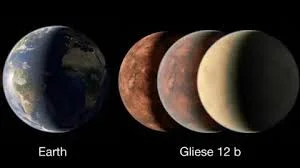
Why in news?
- Astronomers have unveiled an exciting discovery – a potentially habitable exoplanet orbiting a star relatively close to our solar system.
- This newfound world, named Gliese 12 b, sits roughly 40 light-years away, making it one of the closest Earth-sized exoplanets identified so far.
- The details of this discovery were published in a recent study featured in the Monthly Notices of the Royal Astronomical Society.
A Temperate World Beckons
- Gliese 12 b is a captivating prospect because of its potential to harbor life. With an average surface temperature estimated at around 42 degrees Celsius, it falls within a more temperate range compared to the majority of the exoplanets discovered thus far (over 5,000).
- While warmer than Earth’s average of 15°C, this temperature warrants further investigation into the exoplanet’s characteristics, particularly its atmosphere, which plays a crucial role in supporting life as we know it.
A Collaborative Effort Yields Results
- The discovery of Gliese 12 b is a testament to international collaboration in space exploration.
- NASA’s Transiting Exoplanet Survey Satellite (TESS) initially flagged the exoplanet as a potential candidate.
- Following up on this lead, a research team co-led by Masayuki Kuzuhara (Astrobiology Center, Tokyo) and Akihiko Fukui (University of Tokyo) utilized data from both TESS and the European Space Agency’s CHaracterising ExOPlanet Satellite (CHEOPS) to confirm the existence of Gliese 12 b.
A Star System with Intriguing Neighbors
- Gliese 12 b is part of a bustling planetary system orbiting a cool, low-mass star called Gliese 12, classified as an M dwarf. Interestingly, this star system boasts seven planets, all roughly Earth-sized and likely rocky in composition.
- Three of these planets reside within the habitable zone, the region around a star where liquid water can potentially exist on a planet’s surface.
- The M dwarf star itself holds some intriguing characteristics. Compared to our Sun, it has a lower metal content, suggesting weaker magnetic fields and potentially higher volcanic activity on orbiting planets.
- However, this lower magnetic activity may also imply that Gliese 12 b could retain an atmosphere, a crucial factor for habitability.
Unveiling the Mysteries of Gliese 12 b
- The research team acknowledges the possibility of Gliese 12 b having an atmosphere, but the nature of that atmosphere remains uncertain.
- It could resemble Earth’s atmosphere, or it could be entirely different.
- Further analysis is needed to determine the exoplanet’s suitability for life.
- “We tend to define habitability in terms of liquid water, rather than where humanity would be able to maintain life,” explains Larissa Palethorpe, a PhD student from the University of Edinburgh. “So while this temperature would be a bit on the hot side for humans to live comfortably, it doesn’t necessarily mean other forms of life wouldn’t be able to thrive in these conditions.”
- Investigating Gliese 12 b could not only shed light on the possibility of life beyond Earth but also offer valuable insights into the evolution of our own solar system.
- By studying this exoplanet, scientists hope to understand the stark differences between Earth and Venus, two planets that share similar sizes but vastly different environments.
- Earth’s ability to retain water stands in stark contrast to Venus’ runaway greenhouse effect, which caused its atmosphere to become uninhabitable.
- Studying Gliese 12 b could potentially reveal signatures of such a runaway greenhouse effect, offering clues about its past and future.
A Target for the James Webb Space Telescope
- The research team identifies Gliese 12 b as a prime candidate for further investigation using NASA’s James Webb Space Telescope (JWST).
- This powerful telescope boasts the capability to detect atmospheric features on exoplanets, potentially revealing the composition of Gliese 12 b’s atmosphere and providing valuable clues about its habitability.
- While a JWST proposal for this specific target is yet to be submitted, the research team is currently focused on determining the exoplanet’s mass, bulk density, and radius.
- This information will provide a better understanding of Gliese 12 b’s internal structure and shed light on its overall composition.
- The discovery of Gliese 12 b marks a significant step forward in our quest to find habitable worlds beyond our solar system. With continued exploration and advancements in technology, we may one day unlock the secrets of this intriguing exoplanet and potentially find a glimpse of life elsewhere in the universe.
People also ask
Q1: What is Gliese 12 b?
Ans: Gliese 12 b is a newly discovered exoplanet, a planet outside our solar system, located about 40 light-years away. It’s roughly the size of Earth and resides within the habitable zone of its star, meaning it has the potential to support liquid water on its surface, a key ingredient for life as we know it.
Q2: How was Gliese 12 b discovered?
Ans: The initial detection of Gliese 12 b came from NASA’s Transiting Exoplanet Survey Satellite (TESS). Following up on this lead, a team of researchers confirmed its existence using data from both TESS and the European Space Agency’s CHaracterising ExOPlanet Satellite (CHEOPS).
This is top-notch! I wonder how much effort and time you have spent to come up with these informative posts. Should you be interested in generating more ideas about Thai-Massage, take a look at my website QN9
Your article helped me a lot, is there any more related content? Thanks!
Can you be more specific about the content of your article? After reading it, I still have some doubts. Hope you can help me.
I don’t think the title of your article matches the content lol. Just kidding, mainly because I had some doubts after reading the article.
Your point of view caught my eye and was very interesting. Thanks. I have a question for you.